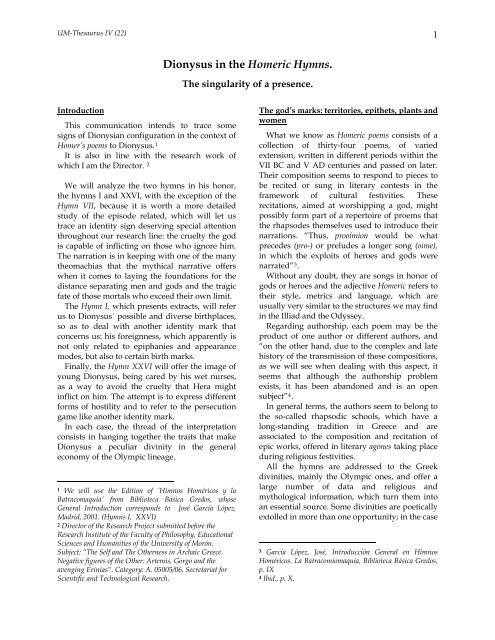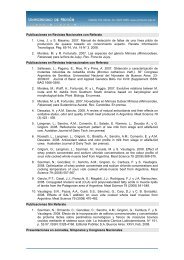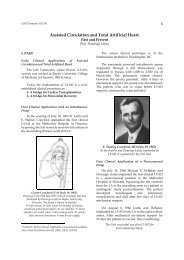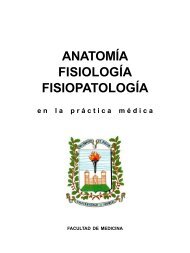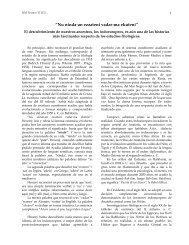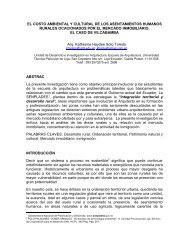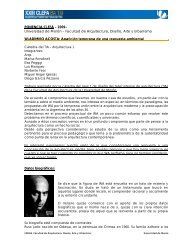Dionysus in the Homeric Hymns. - Universidad de Morón
Dionysus in the Homeric Hymns. - Universidad de Morón
Dionysus in the Homeric Hymns. - Universidad de Morón
You also want an ePaper? Increase the reach of your titles
YUMPU automatically turns print PDFs into web optimized ePapers that Google loves.
UM-Thesaurus IV (22)<br />
Introduction<br />
This communication <strong>in</strong>tends to trace some<br />
signs of Dionysian configuration <strong>in</strong> <strong>the</strong> context of<br />
Homer’s poems to <strong>Dionysus</strong>. 1<br />
It is also <strong>in</strong> l<strong>in</strong>e with <strong>the</strong> research work of<br />
which I am <strong>the</strong> Director. 2<br />
We will analyze <strong>the</strong> two hymns <strong>in</strong> his honor,<br />
<strong>the</strong> hymns I and XXVI, with <strong>the</strong> exception of <strong>the</strong><br />
Hymn VII, because it is worth a more <strong>de</strong>tailed<br />
study of <strong>the</strong> episo<strong>de</strong> related, which will let us<br />
trace an i<strong>de</strong>ntity sign <strong>de</strong>serv<strong>in</strong>g special attention<br />
throughout our research l<strong>in</strong>e: <strong>the</strong> cruelty <strong>the</strong> god<br />
is capable of <strong>in</strong>flict<strong>in</strong>g on those who ignore him.<br />
The narration is <strong>in</strong> keep<strong>in</strong>g with one of <strong>the</strong> many<br />
<strong>the</strong>omachias that <strong>the</strong> mythical narrative offers<br />
when it comes to lay<strong>in</strong>g <strong>the</strong> foundations for <strong>the</strong><br />
distance separat<strong>in</strong>g men and gods and <strong>the</strong> tragic<br />
fate of those mortals who exceed <strong>the</strong>ir own limit.<br />
The Hymn I, which presents extracts, will refer<br />
us to <strong>Dionysus</strong>´ possible and diverse birthplaces,<br />
so as to <strong>de</strong>al with ano<strong>the</strong>r i<strong>de</strong>ntity mark that<br />
concerns us: his foreignness, which apparently is<br />
not only related to epiphanies and appearance<br />
mo<strong>de</strong>s, but also to certa<strong>in</strong> birth marks.<br />
F<strong>in</strong>ally, <strong>the</strong> Hymn XXVI will offer <strong>the</strong> image of<br />
young <strong>Dionysus</strong>, be<strong>in</strong>g cared by his wet nurses,<br />
as a way to avoid <strong>the</strong> cruelty that Hera might<br />
<strong>in</strong>flict on him. The attempt is to express different<br />
forms of hostility and to refer to <strong>the</strong> persecution<br />
game like ano<strong>the</strong>r i<strong>de</strong>ntity mark.<br />
In each case, <strong>the</strong> thread of <strong>the</strong> <strong>in</strong>terpretation<br />
consists <strong>in</strong> hang<strong>in</strong>g toge<strong>the</strong>r <strong>the</strong> traits that make<br />
<strong>Dionysus</strong> a peculiar div<strong>in</strong>ity <strong>in</strong> <strong>the</strong> general<br />
economy of <strong>the</strong> Olympic l<strong>in</strong>eage.<br />
1 We will use <strong>the</strong> Edition of ´Himnos Homéricos y la<br />
Batracomaquia´ from Biblioteca Básica Gredos, whose<br />
General Introduction corresponds to José García López,<br />
Madrid, 2001. (<strong>Hymns</strong> I, XXVI)<br />
2 Director of <strong>the</strong> Research Project submitted before <strong>the</strong><br />
Research Institute of <strong>the</strong> Faculty of Philosophy, Educational<br />
Sciences and Humanities of <strong>the</strong> University of <strong>Morón</strong>.<br />
Subject: “The Self and The O<strong>the</strong>rness <strong>in</strong> Archaic Greece.<br />
Negative figures of <strong>the</strong> O<strong>the</strong>r: Artemis, Gorgo and <strong>the</strong><br />
aveng<strong>in</strong>g Er<strong>in</strong>ias". Category: A. 05005/06. Secretariat for<br />
Scientific and Technological Research.<br />
<strong>Dionysus</strong> <strong>in</strong> <strong>the</strong> <strong>Homeric</strong> <strong>Hymns</strong>.<br />
The s<strong>in</strong>gularity of a presence.<br />
The god’s marks: territories, epi<strong>the</strong>ts, plants and<br />
women<br />
What we know as <strong>Homeric</strong> poems consists of a<br />
collection of thirty-four poems, of varied<br />
extension, written <strong>in</strong> different periods with<strong>in</strong> <strong>the</strong><br />
VII BC and V AD centuries and passed on later.<br />
Their composition seems to respond to pieces to<br />
be recited or sung <strong>in</strong> literary contests <strong>in</strong> <strong>the</strong><br />
framework of cultural festivities. These<br />
recitations, aimed at worshipp<strong>in</strong>g a god, might<br />
possibly form part of a repertoire of proems that<br />
<strong>the</strong> rhapso<strong>de</strong>s <strong>the</strong>mselves used to <strong>in</strong>troduce <strong>the</strong>ir<br />
narrations. “Thus, prooímion would be what<br />
prece<strong>de</strong>s (pro-) or prelu<strong>de</strong>s a longer song (oime),<br />
<strong>in</strong> which <strong>the</strong> exploits of heroes and gods were<br />
narrated” 3 .<br />
Without any doubt, <strong>the</strong>y are songs <strong>in</strong> honor of<br />
gods or heroes and <strong>the</strong> adjective <strong>Homeric</strong> refers to<br />
<strong>the</strong>ir style, metrics and language, which are<br />
usually very similar to <strong>the</strong> structures we may f<strong>in</strong>d<br />
<strong>in</strong> <strong>the</strong> Illiad and <strong>the</strong> Odyssey.<br />
Regard<strong>in</strong>g authorship, each poem may be <strong>the</strong><br />
product of one author or different authors, and<br />
“on <strong>the</strong> o<strong>the</strong>r hand, due to <strong>the</strong> complex and late<br />
history of <strong>the</strong> transmission of <strong>the</strong>se compositions,<br />
as we will see when <strong>de</strong>al<strong>in</strong>g with this aspect, it<br />
seems that although <strong>the</strong> authorship problem<br />
exists, it has been abandoned and is an open<br />
subject” 4 .<br />
In general terms, <strong>the</strong> authors seem to belong to<br />
<strong>the</strong> so-called rhapsodic schools, which have a<br />
long-stand<strong>in</strong>g tradition <strong>in</strong> Greece and are<br />
associated to <strong>the</strong> composition and recitation of<br />
epic works, offered <strong>in</strong> literary agones tak<strong>in</strong>g place<br />
dur<strong>in</strong>g religious festivities.<br />
All <strong>the</strong> hymns are addressed to <strong>the</strong> Greek<br />
div<strong>in</strong>ities, ma<strong>in</strong>ly <strong>the</strong> Olympic ones, and offer a<br />
large number of data and religious and<br />
mythological <strong>in</strong>formation, which turn <strong>the</strong>m <strong>in</strong>to<br />
an essential source. Some div<strong>in</strong>ities are poetically<br />
extolled <strong>in</strong> more than one opportunity; <strong>in</strong> <strong>the</strong> case<br />
3 García López, José, Introducción General en Himnos<br />
Homéricos. La Batracomiomaquia, Biblioteca Básica Gredos,<br />
p. IX<br />
4 Ibid., p. X.<br />
1
UM-Thesaurus IV (22)<br />
of <strong>Dionysus</strong>, this could be observed on three<br />
occasions.<br />
The composition date of <strong>the</strong> Hymn I is difficult<br />
to <strong>de</strong>term<strong>in</strong>e, s<strong>in</strong>ce, <strong>in</strong> addition to <strong>the</strong> usual<br />
difficulties of <strong>the</strong> hymns, <strong>in</strong> this case we are<br />
<strong>de</strong>al<strong>in</strong>g with fragments. The first fragment makes<br />
reference to his birth, a controversial issue <strong>in</strong> <strong>the</strong><br />
case of <strong>Dionysus</strong> and a habitual hymn topic as an<br />
<strong>in</strong>troduction to div<strong>in</strong>ities.<br />
“…for some say that at Dracanum; and some,<br />
on w<strong>in</strong>dy Icarus; some, <strong>in</strong> Naxos; and o<strong>the</strong>rs by<br />
<strong>the</strong> <strong>de</strong>ep-eddy<strong>in</strong>g river Alpheus pregnant Semele<br />
bore you, Taur<strong>in</strong>e, div<strong>in</strong>e son, to Zeus <strong>the</strong><br />
thun<strong>de</strong>r-lover.” (Hymn I, 1-5).<br />
Two more territories are listed: “And o<strong>the</strong>rs<br />
yet, lord, say you were born <strong>in</strong> Thebes” (5) and<br />
f<strong>in</strong>ally, “There is a certa<strong>in</strong> Nysa, a very high<br />
mounta<strong>in</strong>, far from Phoenice, near <strong>the</strong> streams of<br />
Aegyptus ...” (8-10)<br />
As it can be observed, beyond <strong>the</strong> controversies<br />
regard<strong>in</strong>g <strong>Dionysus</strong>´ mo<strong>the</strong>r country, a polemic<br />
issue that critics have <strong>de</strong>alt with on numberless<br />
opportunities, <strong>the</strong> poem gives geographical<br />
<strong>in</strong>formation on <strong>the</strong> territory, with a certa<strong>in</strong><br />
pedagogical approach. For <strong>in</strong>stance, Dracanum is<br />
a hill on Icarus Island, near Samos, while Naxos<br />
is one of <strong>the</strong> Cycla<strong>de</strong>s Islands and Alpheus is a<br />
river of Elis, be<strong>in</strong>g all of <strong>the</strong>m Dyonisian cult<br />
regions. The mention of Thebes is directly related<br />
to his birth <strong>in</strong> <strong>the</strong> land of his mo<strong>the</strong>r, K<strong>in</strong>g<br />
Cadmus´ beautiful Cadmean daughter, <strong>the</strong><br />
pr<strong>in</strong>cess who got emotionally <strong>in</strong>volved with<br />
Zeus, <strong>the</strong> fa<strong>the</strong>r of men and gods; she was mortal,<br />
he was immortal; <strong>the</strong> relationship built up with<strong>in</strong><br />
<strong>the</strong> field of ontological asymmetries which<br />
separate men from gods; we all know <strong>the</strong><br />
consequences of <strong>the</strong> relationship, result<strong>in</strong>g from<br />
<strong>the</strong> jealousy experienced by <strong>the</strong> legitimate wife of<br />
Zeus, Hera.<br />
Nysa has been etymologically associated with<br />
nymphs, <strong>the</strong> sweet god<strong>de</strong>sses that were <strong>in</strong> charge<br />
of upbr<strong>in</strong>g<strong>in</strong>g <strong>Dionysus</strong>, who, after his birth, was<br />
sewn <strong>in</strong>to <strong>the</strong> thigh of Zeus, where his gestation<br />
was completed after his mo<strong>the</strong>r’s <strong>de</strong>ath caused by<br />
Zeus´ lightn<strong>in</strong>g. Nysa is <strong>the</strong> name of a sacred<br />
range of mounta<strong>in</strong>s located <strong>in</strong> faraway lands, a<br />
product of <strong>the</strong> imag<strong>in</strong>ation, and important to<br />
trace <strong>the</strong> god’s characteristics, consi<strong>de</strong>r<strong>in</strong>g that<br />
<strong>Dionysus</strong>´ name is related to <strong>the</strong> etymological<br />
roots of <strong>the</strong> word, for <strong>in</strong>stance <strong>the</strong> root nysus.<br />
After a long <strong>de</strong>bate on <strong>the</strong> orig<strong>in</strong> of <strong>Dionysus</strong>,<br />
regard<strong>in</strong>g <strong>the</strong> hypo<strong>the</strong>sis of his Tracian or<br />
Phrygian mo<strong>the</strong>r country, Otto consi<strong>de</strong>rs <strong>the</strong><br />
hypo<strong>the</strong>sis of his com<strong>in</strong>g from Phrygia or Tracia<br />
little conv<strong>in</strong>c<strong>in</strong>g and does admit very old<br />
knowledge of <strong>the</strong> Dionysian religion by <strong>the</strong><br />
Greeks.<br />
“Be favorable, O Taur<strong>in</strong>e, Inspirer of frenzied<br />
women! We, <strong>the</strong> Ae<strong>de</strong>s, s<strong>in</strong>g of you as we beg<strong>in</strong><br />
and as we end a stra<strong>in</strong>, and none forgett<strong>in</strong>g you<br />
may call holy song to m<strong>in</strong>d. And so, be glad,<br />
<strong>Dionysus</strong>, Insewn, with your mo<strong>the</strong>r Semele<br />
whom men call Thyone” (8-12), as <strong>the</strong> poem goes<br />
to <strong>in</strong>dicate <strong>the</strong> noble l<strong>in</strong>eage of his birth, beyond<br />
<strong>the</strong> heterogeneous union referred to. The epi<strong>the</strong>t<br />
Taur<strong>in</strong>e is part of an i<strong>de</strong>ntity mark of <strong>the</strong> god,<br />
who is usually i<strong>de</strong>ntified with <strong>the</strong> bull. In fact, he<br />
always appears accompanied by animals; <strong>the</strong> bull<br />
is, toge<strong>the</strong>r with <strong>the</strong> donkey and <strong>the</strong> billy goat,<br />
<strong>the</strong> symbol of fertility and fertiliz<strong>in</strong>g pleasure.<br />
The bull is also <strong>the</strong> animal that <strong>the</strong> maenads<br />
quarter <strong>in</strong> <strong>the</strong> ritual that characterizes <strong>the</strong>m as<br />
god worshippers. Thus, fierce bulls lean <strong>the</strong>ir<br />
heads un<strong>de</strong>r <strong>the</strong> violent hands of those women,<br />
seized with madness, but capable of <strong>the</strong> greatest<br />
miracle: to atta<strong>in</strong> liberation, katharsis, <strong>in</strong> <strong>the</strong> same<br />
act of mania.<br />
It is <strong>the</strong> Taur<strong>in</strong>e because <strong>the</strong> strength caused by<br />
<strong>the</strong> <strong>in</strong>toxicat<strong>in</strong>g w<strong>in</strong>e is similar to <strong>the</strong> bull’s<br />
fierceness, an image that is present before <strong>the</strong><br />
eyes of <strong>the</strong> followers when <strong>the</strong>y <strong>in</strong>voke <strong>the</strong> god <strong>in</strong><br />
<strong>the</strong>ir <strong>in</strong>itiation ceremonies. There appears <strong>the</strong><br />
Taurus-<strong>Dionysus</strong>, <strong>the</strong> god-animal, a div<strong>in</strong>ity<br />
closer than <strong>the</strong> distant Apollo, and with whom it<br />
seems to be possible to have a closer<br />
communication. That is, <strong>in</strong><strong>de</strong>ed, <strong>the</strong> Taur<strong>in</strong>e’s<br />
promise: a closer contact that promises to forget<br />
for a while <strong>the</strong> mortal condition. His bellow<strong>in</strong>g is<br />
also <strong>the</strong> bull’s bellow<strong>in</strong>g. <strong>Dionysus</strong> Bromius is <strong>the</strong><br />
mark of an uncontrollable rage.<br />
Euripi<strong>de</strong>s himself refers to <strong>the</strong> similarityi<strong>de</strong>ntity,<br />
when <strong>the</strong> chorus is <strong>in</strong> charge of call<strong>in</strong>g<br />
on <strong>the</strong> god so that he turns <strong>in</strong>to a bull; even<br />
Pen<strong>the</strong>us sees him like that <strong>in</strong> his <strong>in</strong>cipient<br />
<strong>de</strong>lirium, or when he calls him Bromius, <strong>the</strong> one<br />
who bellows.<br />
The chorus mentions <strong>the</strong> name <strong>in</strong> <strong>the</strong> same<br />
proem: “From Asia, hav<strong>in</strong>g abandoned Tmolus, I<br />
hasten to a pleasant task, a toil that br<strong>in</strong>gs no<br />
wear<strong>in</strong>ess, <strong>in</strong> honour of Bromius, thus celebrat<strong>in</strong>g<br />
<strong>the</strong> bacchanalia with <strong>the</strong> evohé” (The Bacchantes).<br />
2
UM-Thesaurus IV (22)<br />
The taur<strong>in</strong>e reference from <strong>the</strong> mouth of <strong>the</strong><br />
chorus appears <strong>in</strong> The Bacchantes, 1017: “Appear,<br />
O Bacchus, to our eyes as a bull or serpent with a<br />
hundred heads, or take <strong>the</strong> shape of a lion<br />
breath<strong>in</strong>g flame!”<br />
From ano<strong>the</strong>r view, <strong>the</strong> mentioned verses are<br />
ano<strong>the</strong>r sign of i<strong>de</strong>ntity, which will accompany<br />
<strong>the</strong> god <strong>in</strong> his epiphanic drift<strong>in</strong>g: his capacity to<br />
drive women crazy. The maenads are <strong>the</strong> first<br />
victims of <strong>the</strong> discourtesy <strong>the</strong> cities have before<br />
<strong>the</strong> god, by not recogniz<strong>in</strong>g and not do<strong>in</strong>g honor<br />
to him. The women get mad because of<br />
Bromius´do<strong>in</strong>g, and his mo<strong>the</strong>r, Semele-Thione<br />
(maenad) appears like a mythical archetype of a<br />
possessed woman.<br />
The relationship of <strong>Dionysus</strong> with women goes<br />
through a complex field, but what is un<strong>de</strong>niable<br />
is <strong>the</strong> repeated presence of <strong>the</strong> fem<strong>in</strong><strong>in</strong>e <strong>in</strong> his<br />
configuration as a div<strong>in</strong>ity.<br />
From his upbr<strong>in</strong>g<strong>in</strong>g by <strong>the</strong> Nymphs to <strong>the</strong><br />
episo<strong>de</strong>s of harsher mania, women become a<br />
central element <strong>in</strong> Dionysian epiphany. They, <strong>the</strong><br />
Bacchantes, are <strong>the</strong> faithful worshippers of a god<br />
that punishes <strong>the</strong>m with <strong>the</strong> purpose of sav<strong>in</strong>g<br />
<strong>the</strong>m, pursues <strong>the</strong>m to make <strong>the</strong>m free <strong>in</strong> a<br />
unique and sublime act of approach<strong>in</strong>gassimilation<br />
to <strong>the</strong> div<strong>in</strong>ity. 5 They are <strong>the</strong><br />
followers of <strong>Dionysus</strong> and, above all, <strong>the</strong><br />
privileged women <strong>in</strong>itiated <strong>in</strong>to his rites on <strong>the</strong><br />
mounta<strong>in</strong>.<br />
Follow<strong>in</strong>g this, we propose to consi<strong>de</strong>r <strong>the</strong><br />
Hymn XXVI, also <strong>de</strong>dicated to <strong>Dionysus</strong>. The<br />
ma<strong>in</strong> subject is <strong>the</strong> god’s upbr<strong>in</strong>g<strong>in</strong>g, which<br />
br<strong>in</strong>gs about two topics already mentioned; on<br />
one hand, <strong>the</strong> traumatic birth consi<strong>de</strong>r<strong>in</strong>g <strong>the</strong><br />
heterogeneity of his parents, and <strong>the</strong> fem<strong>in</strong><strong>in</strong>e<br />
presence s<strong>in</strong>ce he was a child, accompanied by<br />
<strong>the</strong> Nymphs, his wet-nurses.<br />
A third element to be consi<strong>de</strong>red, and traceable<br />
<strong>in</strong> <strong>the</strong> verses of <strong>the</strong> analyzed hymn, is <strong>the</strong><br />
reference to <strong>the</strong> god’s adorned head as a<br />
dist<strong>in</strong>ctive trait of his personality, which creates a<br />
po<strong>in</strong>t of contact with <strong>the</strong> vegetation as an i<strong>de</strong>ntity<br />
core. Let’s have a look at <strong>the</strong> verses: “I beg<strong>in</strong> to<br />
s<strong>in</strong>g of ivy-crowned <strong>Dionysus</strong>, <strong>the</strong> loud-cry<strong>in</strong>g<br />
5 We evoke here <strong>the</strong> hypo<strong>the</strong>sis formulated by Louis Gernet<br />
regard<strong>in</strong>g <strong>the</strong> double assimilation-approach<strong>in</strong>g movement<br />
which seems to support <strong>the</strong> anthropological field of archaic<br />
religion, as <strong>the</strong>y are <strong>the</strong> two movements tend<strong>in</strong>g to erase <strong>the</strong><br />
natural distance that separates mortals from immortals.<br />
god, splendid son of Zeus and glorious Semele.<br />
The rich-haired Nymphs received him <strong>in</strong> <strong>the</strong>ir<br />
bosoms from <strong>the</strong> lord his fa<strong>the</strong>r.” (Hymn XXVI, 1-<br />
4) and “His head adorned with his own black<br />
bunches” (Hymn I, 2). The same reference to his<br />
hair. In one case adorned with ivy and <strong>in</strong> <strong>the</strong><br />
o<strong>the</strong>r case with v<strong>in</strong>e. In both cases, it is <strong>in</strong>ten<strong>de</strong>d<br />
to trace <strong>Dionysus</strong>´ manifestation <strong>in</strong> vegetation, an<br />
<strong>in</strong>tense association that places <strong>the</strong> god <strong>in</strong> <strong>the</strong><br />
framework of a generat<strong>in</strong>g and productive<br />
power. Accord<strong>in</strong>g to Otto, “In <strong>the</strong> v<strong>in</strong>e grows<br />
<strong>Dionysus</strong>´ madness and it spreads to everybody<br />
who enjoys his miraculous juices. That is why it is<br />
<strong>the</strong> most notable symbol of <strong>the</strong> god, <strong>the</strong> best<br />
guarantee of his presence.” 6 Although it is <strong>the</strong><br />
v<strong>in</strong>e which seems to accompany him <strong>in</strong>tensely,<br />
<strong>the</strong> contact with <strong>the</strong> nature world goes beyond<br />
<strong>the</strong> limits of <strong>the</strong> v<strong>in</strong>e and, toge<strong>the</strong>r with it, <strong>the</strong> ivy<br />
is <strong>the</strong> god’s favorite plant, which adorns and<br />
characterizes him.<br />
The v<strong>in</strong>e and <strong>the</strong> ivy are near relatives which<br />
have <strong>de</strong>veloped differently but are un<strong>de</strong>niably<br />
close. In many traditions of Dionysiac cult, <strong>the</strong><br />
ivy is present <strong>in</strong> wreath shape, encircl<strong>in</strong>g <strong>the</strong><br />
thyrsus, thus protect<strong>in</strong>g <strong>the</strong> god dur<strong>in</strong>g his birth<br />
to save him from <strong>the</strong> flames that surroun<strong>de</strong>d her<br />
unfortunate mo<strong>the</strong>r; it got tangled <strong>in</strong> <strong>the</strong> house of<br />
his grandfa<strong>the</strong>r, Cadmus, so that <strong>the</strong> strength of<br />
<strong>the</strong> branches might protect him from <strong>the</strong><br />
earthquake that struck <strong>the</strong> palace; hence <strong>the</strong><br />
Thebans consi<strong>de</strong>red it sacred <strong>the</strong> column covered<br />
by ivy that had been consecrated to <strong>the</strong> god, and<br />
called him “<strong>the</strong> one surroun<strong>de</strong>d by columns” or<br />
perikionios (Διονυσος Περικιονιος). 7<br />
The ivy and <strong>the</strong> v<strong>in</strong>e are similar regard<strong>in</strong>g <strong>the</strong>ir<br />
growth processes and both suffer a phenomenal<br />
transmutation. The v<strong>in</strong>e looks <strong>de</strong>ad <strong>in</strong> <strong>the</strong> cold<br />
season until <strong>the</strong> heat com<strong>in</strong>g from <strong>the</strong> sun rays<br />
<strong>in</strong>tensifies its greenness, thus produc<strong>in</strong>g an<br />
ar<strong>de</strong>nt juice. It turns from a dry and sterile plant<br />
<strong>in</strong>to a won<strong>de</strong>rfully prodigious one. Regard<strong>in</strong>g <strong>the</strong><br />
ivy, it offers its shady stems and climb<strong>in</strong>g<br />
branches. But later, its stems become straighter<br />
and its leaves take on o<strong>the</strong>r characteristics, while<br />
its flowers and fruit come out. Accord<strong>in</strong>g to Otto,<br />
“Like <strong>Dionysus</strong>, it could well be called <strong>the</strong> twiceborn.”<br />
8<br />
6 Otto, Quoted work, p. 113.<br />
7 Ibid., p. 114.<br />
8 Ibid., p. 114.<br />
3
UM-Thesaurus IV (22)<br />
There have been mentioned so far some of <strong>the</strong><br />
characteristics of two plants, strongly associated<br />
to <strong>the</strong> vegetative aspect of <strong>Dionysus</strong>, who<br />
proudly ga<strong>the</strong>rs <strong>the</strong>m on his div<strong>in</strong>e head.<br />
His birth is <strong>the</strong> new topic to be <strong>de</strong>veloped,<br />
because of <strong>the</strong> presence of <strong>the</strong> Nymphs. The myth<br />
relates Zeus´ need to <strong>de</strong>liver his son to <strong>the</strong><br />
custody of <strong>the</strong> beautiful wet-nurses who will<br />
teach him <strong>the</strong> value of <strong>the</strong> woods, as <strong>the</strong> first<br />
topos familiar to <strong>the</strong> child.<br />
Hera’s jealousy and <strong>the</strong> premature <strong>de</strong>ath of<br />
Semele, struck by a lightn<strong>in</strong>g, make it necessary<br />
<strong>the</strong> Nymphs´custody. The hymn rem<strong>in</strong>ds <strong>the</strong><br />
glory of his birth, without forgett<strong>in</strong>g <strong>the</strong> status of<br />
his fa<strong>the</strong>r Zeus, <strong>the</strong> illustrious, and his mo<strong>the</strong>r,<br />
<strong>the</strong> glorious Cadmean, always remembered by<br />
any hymn mention<strong>in</strong>g her.<br />
However, <strong>the</strong> rich-haired Nymphs received<br />
him <strong>in</strong> <strong>the</strong>ir bosoms from Zeus himself, his<br />
fa<strong>the</strong>r, and “fostered and nurtured him carefully<br />
<strong>in</strong> <strong>the</strong> <strong>de</strong>lls of Nysa, where by <strong>the</strong> will of his<br />
fa<strong>the</strong>r he grew up <strong>in</strong> a sweet-smell<strong>in</strong>g cave, be<strong>in</strong>g<br />
reckoned among <strong>the</strong> immortals” (Hymn XXVI, 4-<br />
7). Besi<strong>de</strong>s <strong>the</strong> presentation of his wet-nurses,<br />
here come some important data. The s<strong>in</strong>gularity<br />
of <strong>Dionysus</strong>´ birth, due to <strong>the</strong> heterogeneous<br />
status of his parents, his fa<strong>the</strong>r-immortal and her<br />
mo<strong>the</strong>r-mortal, does not sully <strong>the</strong> div<strong>in</strong>e nature<br />
of <strong>the</strong> son, always recognized by his fa<strong>the</strong>r and<br />
<strong>the</strong> immortals. <strong>Dionysus</strong> has always had a place<br />
among <strong>the</strong>m and Zeus has taken him <strong>in</strong> his lap<br />
with sav<strong>in</strong>g plans; hence <strong>the</strong> express mention to<br />
<strong>the</strong> fa<strong>the</strong>r’s will and <strong>the</strong> place among <strong>the</strong><br />
immortals.<br />
The nymphs represent an <strong>in</strong>augural<br />
fem<strong>in</strong><strong>in</strong>e presence <strong>in</strong> <strong>Dionysus</strong>´ life, while <strong>the</strong>y<br />
mean a mythical foundation mark: <strong>the</strong> selfsacrific<strong>in</strong>g<br />
br<strong>in</strong>g<strong>in</strong>g-up as a female trait. They are<br />
<strong>the</strong> perfect wet-nurses, able to take him <strong>in</strong>to <strong>the</strong>ir<br />
bosom and tak<strong>in</strong>g care of him, before be<strong>in</strong>g<br />
<strong>the</strong>mselves who acquire ecstatic marks and turn<br />
<strong>in</strong>to a frenzied chorus of followers, as stated <strong>in</strong><br />
<strong>the</strong> second part of <strong>the</strong> Hymn, when it says: “But<br />
when <strong>the</strong> god<strong>de</strong>sses had brought him up, a god<br />
oft hymned, he already wan<strong>de</strong>red cont<strong>in</strong>ually<br />
through <strong>the</strong> woody valleys, thickly wrea<strong>the</strong>d<br />
with ivy and laurel. And <strong>the</strong> Nymphs followed <strong>in</strong><br />
his tra<strong>in</strong> with him for <strong>the</strong>ir lea<strong>de</strong>r; and <strong>the</strong><br />
boundless forest was filled with <strong>the</strong>ir outcry.”<br />
(Hymn XXVI, 8-11).<br />
A first mark places us <strong>in</strong> <strong>the</strong> Nymph-wet nurse:<br />
<strong>the</strong> territory mark. Like a mo<strong>the</strong>r, <strong>the</strong> div<strong>in</strong>e wet-<br />
nurses teach <strong>the</strong> child <strong>the</strong> first topos, <strong>in</strong> <strong>the</strong> place<br />
where <strong>the</strong> first steps are taken and he becomes<br />
familiar with <strong>the</strong> first geography that marks a<br />
man for <strong>the</strong> rest of his life; <strong>in</strong><strong>de</strong>ed, <strong>the</strong> wan<strong>de</strong>r<strong>in</strong>g<br />
through <strong>the</strong> woods and <strong>the</strong>ir darkness will be <strong>the</strong><br />
i<strong>de</strong>ntity traits of <strong>the</strong> div<strong>in</strong>ity, a lover of<br />
cosmopolitanism implied <strong>in</strong> nomadism and<br />
<strong>in</strong>habitant of <strong>the</strong> peculiar geography of <strong>the</strong> wood<br />
as a scenario of ritual complexity.<br />
But <strong>the</strong>y are also <strong>the</strong> ones who double <strong>the</strong>ir first<br />
i<strong>de</strong>ntity and turn <strong>in</strong>to bacchantes. Nymph-dancer<br />
that accompanies <strong>the</strong> grown-up god <strong>in</strong> his<br />
frenzied dance; i<strong>de</strong>ntity double that, like<br />
<strong>Dionysus</strong> himself, <strong>de</strong>picts more than a multicolor<br />
personality trait.<br />
Accord<strong>in</strong>g to Otto: “it is evi<strong>de</strong>nt that <strong>the</strong><br />
Thia<strong>de</strong>s, who, like <strong>the</strong>m, take care of <strong>Dionysus</strong><br />
and like <strong>the</strong>m go danc<strong>in</strong>g all over <strong>the</strong> heights,<br />
play <strong>the</strong> role of div<strong>in</strong>e women and represent <strong>in</strong><br />
<strong>the</strong> cult <strong>the</strong>ir behavior, which is partly maternal,<br />
partly ecstatic, and always related to nature.” 9<br />
Mo<strong>the</strong>r-maenad, <strong>the</strong> Nymphs seem to give rise to<br />
a mythical double, where life and <strong>de</strong>ath,<br />
ten<strong>de</strong>rness and horror, light and shadow seem to<br />
dance <strong>in</strong> <strong>the</strong> same frenzied turmoil which marks<br />
Dionysian s<strong>in</strong>gularity.<br />
<strong>Dionysus</strong> is, of course, <strong>the</strong> one <strong>in</strong> charge of<br />
lead<strong>in</strong>g his followers, as it corresponds to whom<br />
holds <strong>the</strong> most genu<strong>in</strong>e div<strong>in</strong>e mark, while “<strong>the</strong><br />
clamor seized on <strong>the</strong> huge woods” (11)<br />
The f<strong>in</strong>al part of <strong>the</strong> chant shows <strong>the</strong> <strong>in</strong>tonation<br />
at <strong>the</strong> end of a party; as it is stated by <strong>the</strong><br />
<strong>in</strong>vocation and wait for a new festivity, once <strong>the</strong><br />
cycle of seasons is over. “And so hail to you,<br />
<strong>Dionysus</strong>, god of abundant clusters. Grant that<br />
we may come aga<strong>in</strong> rejoic<strong>in</strong>g to this season, and<br />
from that season onwards for many years. (Hymn<br />
XXVI, 12-15).<br />
Conclusions<br />
This work has been an attempt to go through<br />
<strong>Dionysus</strong>´ peculiarities from <strong>the</strong> <strong>in</strong>terpretation<br />
offered by <strong>the</strong> <strong>Hymns</strong>. The marks are those<br />
habitually found <strong>in</strong> div<strong>in</strong>ity and <strong>the</strong> topics<br />
familiar to Dionysian <strong>de</strong>piction are ga<strong>the</strong>red <strong>in</strong><br />
<strong>the</strong> hymns: his traumatic birth and <strong>the</strong> stances<br />
regard<strong>in</strong>g his orig<strong>in</strong>, <strong>the</strong> epi<strong>the</strong>ts typical of him,<br />
Taur<strong>in</strong>e and Bromius, and <strong>the</strong> number of<br />
connections <strong>in</strong>volved.<br />
9 Ibid., p. 64.<br />
4
UM-Thesaurus IV (22)<br />
We have also <strong>in</strong>vestigated, as an i<strong>de</strong>ntity mark,<br />
<strong>the</strong> l<strong>in</strong>k between <strong>Dionysus</strong> and <strong>the</strong> vegetative<br />
nature to enhance <strong>the</strong> value of two emblematic<br />
plants, <strong>the</strong> v<strong>in</strong>e and <strong>the</strong> ivy, which, toge<strong>the</strong>r with<br />
<strong>the</strong> previous topic, place <strong>Dionysus</strong> <strong>in</strong> close<br />
communication with <strong>the</strong> natural world, both <strong>the</strong><br />
animal and <strong>the</strong> vegetal sphere, pictur<strong>in</strong>g that<br />
god’s dual nature where life and <strong>de</strong>ath seem to<br />
complement each o<strong>the</strong>r.<br />
F<strong>in</strong>ally it is remarked <strong>the</strong> presence of women, a<br />
frequent close contact which makes up <strong>the</strong> god’s<br />
s<strong>in</strong>gularity. In this opportunity, <strong>the</strong> Nymphs´<br />
figure expla<strong>in</strong>s <strong>the</strong> l<strong>in</strong>k and opens <strong>the</strong> <strong>in</strong>tr<strong>in</strong>sic<br />
duality to <strong>Dionysus</strong> himself: wet-nurses and<br />
dancers, substitute mo<strong>the</strong>rs and first bacchantes<br />
<strong>in</strong> an isomorphic i<strong>de</strong>ntity double from <strong>the</strong><br />
doubles shown by <strong>Dionysus</strong> himself.<br />
Bibliography<br />
Himnos Homéricos. La Batracomiomaquia. 2001. Gredos,<br />
Madrid.<br />
Gernet, Louis. 1981. Antropología <strong>de</strong> la Grecia Antigua.<br />
Taurus, Madrid.<br />
Nilsson, Martín P. 1969. Historia <strong>de</strong> la religiosidad griega.<br />
Gredos, Madrid.<br />
Otto, Walter. 1997. Dioniso. Mito y Culto, Siruela,<br />
Madrid<br />
Sissa, Giulia and Detienne, Marcel. 1990. La vida<br />
cotidiana <strong>de</strong> los dioses griegos. Ediciones Temas <strong>de</strong><br />
Hoy, Madrid.<br />
Vernant, J.-P. 2001. Mito y pensamiento en la Grecia<br />
Antigua Ariel, Barcelona.<br />
Vernant, J.-P. 2001. Mito y Religión en la Grecia Antigua<br />
Ariel, Barcelona.<br />
Vernant, J.-P. 2000. Érase una vez…El universo, los<br />
dioses, los hombres. F.C.E, Bs. As.<br />
María Cecilia COLOMBANI<br />
Faculty of Philosophy, Educational Sciences and<br />
Humanities. University of <strong>Morón</strong>.<br />
Faculty of Humanities. Mar <strong>de</strong>l Plata National University.<br />
mcolombani@unimoron.edu.ar<br />
***<br />
5


